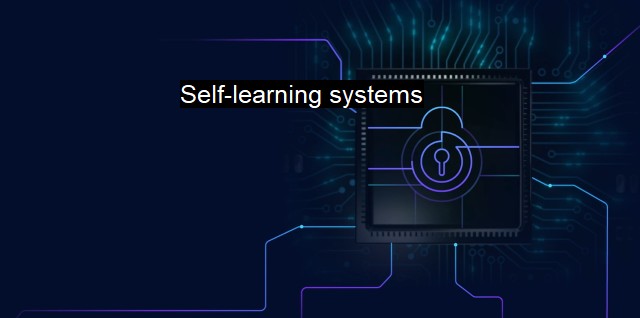What are Self-learning systems?
Revolutionizing Cybersecurity: The Promise of Self-Learning Systems in Threat Detection and Response
"Self-learning systems" is gaining prominence in the realm of computer science and artificial intelligence, and therefore becoming increasingly relevant in diverse areas of human life including cybersecurity and antivirus systems. The central feature of these systems is machine learning algorithms that use computational methods to "learn" information directly from data without relying on a predetermined equation. It involves self-modification of inner workings or internal structure, to improve efficiency or productivity in performing tasks largely in dynamic environments.The role of self-learning in cybersecurity and antivirus protection is fundamental, especially in today's evolving cyber landscape. Given the rapid progression of modern technology, conventional antivirus methods have their limitations and may struggle to keep up with innovative hacking and malware techniques. An antivirus system fortified with a self-learning algorithm marks a shift from merely managing known threats to detecting and responding to new, unfamiliar attacks in real-time, thus offering a targeted, proactive, and intelligent defense mechanism.
In a typical scenario, a self-learning system adapted for cybersecurity examines a fillip of data from systemic operations. The data ranges from traffic exchanges and tooling advances to examining anomalies and behavioral patterns in system use, actions of users, and much more. As it processes this vast swath of information, the system comprehends first whether it is working optimally, spots blur anomalies, and then determines whether these anomalies pose a threat.
As the nature, intensity, and occurrence of cybersecurity threats constantly change, so do the thresholds and criteria that a cybersecurity mechanism uses to identify and resolve concerns. Just as the human immune system does not fight present infections based on past ones, a self-learning system does not rest solely on its memory of prior operations to evaluate current situations. It alternately scrutinizes patterns and investigates exceptions to decide whether they are malicious or benign. the system uses data relating to previously encountered threats to qualify what is normal and what constitutes an anomaly.
One critical aspect of this algorithm is its use of unsupervised learning. This sophisticated machine learning process allows a network to examine its intrinsic data configurations, adapt to changing conditions, and divert resources to address the most effective issues. All these happen without requiring human intervention, freeing up IT personnel to take on more critical tasks. Basically, the system learns from its mistakes and experiences and gradually optimizes itself, reducing false positives and quickening threat response times, hence improving the general defensive posture.
These critical capabilities have dramatically simplified the threat landscape and improved the response to rising cybersecurity concerns, especially widespread malware attacks through drive-by downloads, phishing scams, downloaders, Dropper, and malicious macros, among other threats.
Also, self-learning systems present a measure suitable for enterprises and businesses. These large bodies offer an ideal condition for machine learning applications to shine – they possess irregular event streams, constantly changing user patterns, and involving several entities. When deployed in such environments, self-learning cybersecurity systems smartly target internal threats, detect unknown embedded malware, thwart sophisticated attacks, and reduce security breaches.
Self-learning systems hold immense potential and promise in cybersecurity and antivirus applications. These algorithms represent the next phase in the ongoing quest to cope with the incessant menace of ever-growing, ever-evolving cyber threats. Surely the cyber realm will present more formidable challenges, but the ability self-learning combine with human intuition and innovation would be one to levy and one that will guide our collective journey in securing our digital landscape.

Self-learning systems FAQs
What are self-learning systems in cybersecurity and antivirus?
Self-learning systems in cybersecurity and antivirus refer to artificial intelligence-based systems that can automatically adapt to new threats and attacks, learn from past incidents, and improve their performance over time without human intervention.How do self-learning systems work in cybersecurity and antivirus?
Self-learning systems in cybersecurity and antivirus use machine learning algorithms and other AI techniques to identify patterns and anomalies in network traffic, malware behavior, and other relevant data. They can then use this information to update their defenses, identify new threats, and take appropriate actions to mitigate risks.What are the benefits of using self-learning systems in cybersecurity and antivirus?
The benefits of using self-learning systems in cybersecurity and antivirus include improved threat detection and response times, reduced false positives and negatives, greater accuracy and efficiency, and the ability to adapt to new threats and attack vectors as they emerge.What are some examples of self-learning systems in cybersecurity and antivirus?
Some examples of self-learning systems in cybersecurity and antivirus include machine learning-based malware detection tools like Cylance, heuristic antivirus software like ESET, and security information and event management (SIEM) systems like Splunk that use AI to analyze security logs and detect potential threats.| | A | | | B | | | C | | | D | | | E | | | F | | | G | | | H | | | I | | | J | | | K | | | L | | | M | |
| | N | | | O | | | P | | | Q | | | R | | | S | | | T | | | U | | | V | | | W | | | X | | | Y | | | Z | |
| | 1 | | | 2 | | | 3 | | | 4 | | | 7 | | | 8 | | |||||||